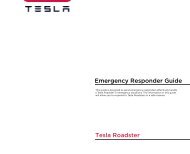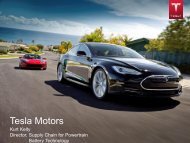You also want an ePaper? Increase the reach of your titles
YUMPU automatically turns print PDFs into web optimized ePapers that Google loves.
University of Oregon Investment Group<br />
April 18, 2013<br />
COGS as they move down the cost curve of production with Model X. In 2017<br />
we increase margins slightly because we project that the firm will introduce the<br />
cheaper version of the Model S. In 2018 we set the gross margin at 25.5% which<br />
we believe is a conservative and reasonable margin for the firm to maintain into<br />
perpetuity given managements guidance.<br />
One-Year Stock Chart<br />
$50.00<br />
$45.00<br />
$40.00<br />
$35.00<br />
$30.00<br />
$25.00<br />
$20.00<br />
$15.00<br />
$10.00<br />
$5.00<br />
$0.00<br />
Oct-11 Dec-11 Feb-12 Apr-12 Jun-12 Aug-12 Oct-12 Dec-12 Feb-13<br />
Volume Adjusted Close 50-Day Avg 200-Day Avg<br />
16000000<br />
14000000<br />
12000000<br />
10000000<br />
8000000<br />
6000000<br />
4000000<br />
2000000<br />
0<br />
Selling General and Administrative Expense (SG&A)<br />
SG&A consist primarily of personnel and facilities cost related to <strong>Tesla</strong> stores,<br />
employment of corporate and retail personnel, and litigation settlements and fees<br />
for professional contract services. Going forward we projected that SG&A<br />
would increase nominally but decrease as a percentage of revenue. In the<br />
coming year the firm plans to open up 10 new stores, which will bring higher<br />
SG&A costs. We projected that the firms SG&A cost would increase by roughly<br />
30% from the prior year because the firm is opening up approximately 30%<br />
more stores. The nominal value and percentage of revenue seemed reasonable to<br />
both Cecilia and I so began to trend down the SG&A as a percentage of revenue.<br />
We believe that as sales grow this line item will continue to increase nominally<br />
but decrease marginally as a percentage of revenue.<br />
Depreciation and Amortization (D&A)<br />
In order to project D&A we used a depreciation table that depreciated historical<br />
Property, Plant, and Equipment and accumulated acquisitions and capital<br />
expenditures. We used straight-line depreciation over 20 years. Although the<br />
group normally depreciates assets over 10 years, we believe our applied length<br />
to be a more accurate assessment of the firms operations. Our belief is rooted in<br />
the fact that the majority of capital expenditures that will be made in 2013 and<br />
going forward are for machinery, factory, and stores. All three of the<br />
aforementioned assets typically have longer depreciation schedules than 10<br />
years. According to the US Treasury, machinery has an average durability 39<br />
years and should therefore be depreciated over 20 years. Furthermore, buildings<br />
such as stores or factories are also included in the 20-year category.<br />
Research and Development (R&D)<br />
Research and development consists of primarily payroll, benefits, stock based<br />
compensation as well as costs related to development services. R&D was<br />
predicted to increase according to <strong>Tesla</strong> management. After following guidance,<br />
we decreased the projected R&D expense as a percentage of revenue while<br />
recognizing nominal increase until 2016. At this point we believe the firms<br />
R&D costs will decrease nominally due to the large expenditures in the prior<br />
years.<br />
UOIG 17







